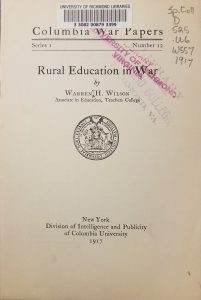The pam phlet I picked to examine is “Rural Education in War,” written by Warren H. Wilson and published in 1917 by the Division of Intelligence and Publicity of Columbia University. This pamphlet was published as part of the Columbia War Papers, a series of similar pamphlets meant to convince Americans to help solve wartime problems and fulfill their national duty.
phlet I picked to examine is “Rural Education in War,” written by Warren H. Wilson and published in 1917 by the Division of Intelligence and Publicity of Columbia University. This pamphlet was published as part of the Columbia War Papers, a series of similar pamphlets meant to convince Americans to help solve wartime problems and fulfill their national duty.
In this pamphlet, Wilson argues that the United States should immediately begin sending high school boys from the cities to work on farms in order to supplement the existing agricultural labor force. This was meant to help prevent a food shortage occurring in the United States like the food shortages occurring in other countries that were involved in the war. Wilson argues that the need is even more pressing because “we are trying to feed Europe as well without increasing the labor on our farms” (3). While not yet old enough for conscription, these city boys could fulfil their duty to the nation’s war effort by doing basic agricultural work which would help increase the nation’s food supply. Each high school would send a corps of boys led by a teacher to a farm where they would be trained by a farmer in basic farming skills.
When reading Wilson’s article, it is clearly recognizable as propaganda because of the rose-colored glasses tone it uses to present a positive and seemingly practical view of a radical idea. At first, Wilson’s plan may seem theoretically viable as he places heavy emphasis on duty to country, however his argument glances over important issues with the program.
Wilson hopes that these new farmhands “will be so pleased by their experience that they will return to it during their vacations in later years” (7). Wilson’s idea of vacation seems a little bit too optimistic. It is clear he does not expect these boys to become farmhands for life. Sending ten out of every fifty boys from every high school could also make a long-term impact on these boys’ futures and the future of the society as the gap in their education would certainly be felt down the road. He also assumes that sending the boys off in groups from the same school will assuage any homesickness that may occur. In reality, subjecting teenagers to a monumental lifestyle change is bound to create some feeling of homesickness, no matter who is present. This program had the potential to create a sizable disruption to daily life.
Wilson believes these boys will be drawn to serve out of loyalty to their country. To assist this, it is suggested that the students wear uniforms “as constant reminders that they are at work not for financial gain, but for service to their country” (6). Even as their sons go off to serve, Wilson also expects their parents to contribute to the initial start-up costs of the program out of their own patriotic responsibility. While ideally the new farmhands would eventually be paid a wage, this does not seem guaranteed. Wilson is trusting that the nationalistic tendencies prevalent during wartime will make this program succeed.
To this extent, it is also worth considering how this pamphlet relates to immigration and the influx of unskilled workers into the country prior to and during the war. At the time, many immigrants were entering the country to do unskilled jobs that Americans were not doing. Taking American boys out of school to do farm work would fill jobs that immigrants traditionally would do, thus possibly discouraging the prosperity of immigrants as their roles are filled by even cheaper labor. Americans were wanted to do American jobs, and they could be drawn to these out of a sense of duty rather than money, thus pricing immigrants out of the market. The anti-immigrant sentiment that was especially prevalent during wartime could have factored into the design of this plan.
While the idea of substituting school with farm service is definitely an interesting twist on the traditional idea of conscription, much like other propaganda, it simplifies an issue in order to gain public support. When closely examined, Wilson’s proposal reads as a short-sighted solution to an extremely complex problem.

Huh! I wonder if the program ever got going. Definitely more interesting than the pamphlet title suggested.